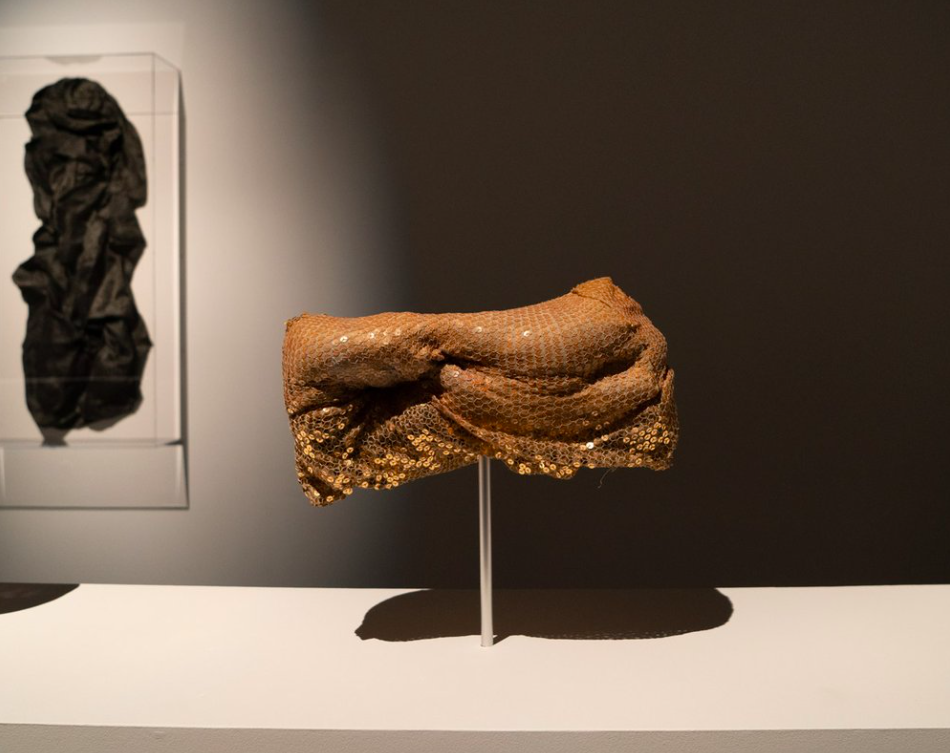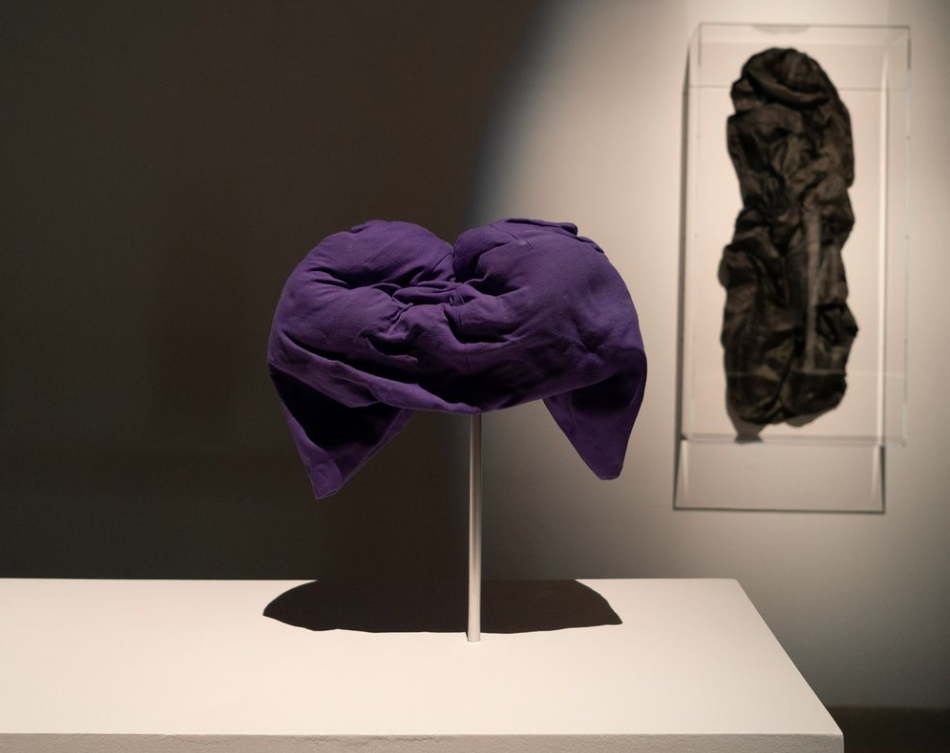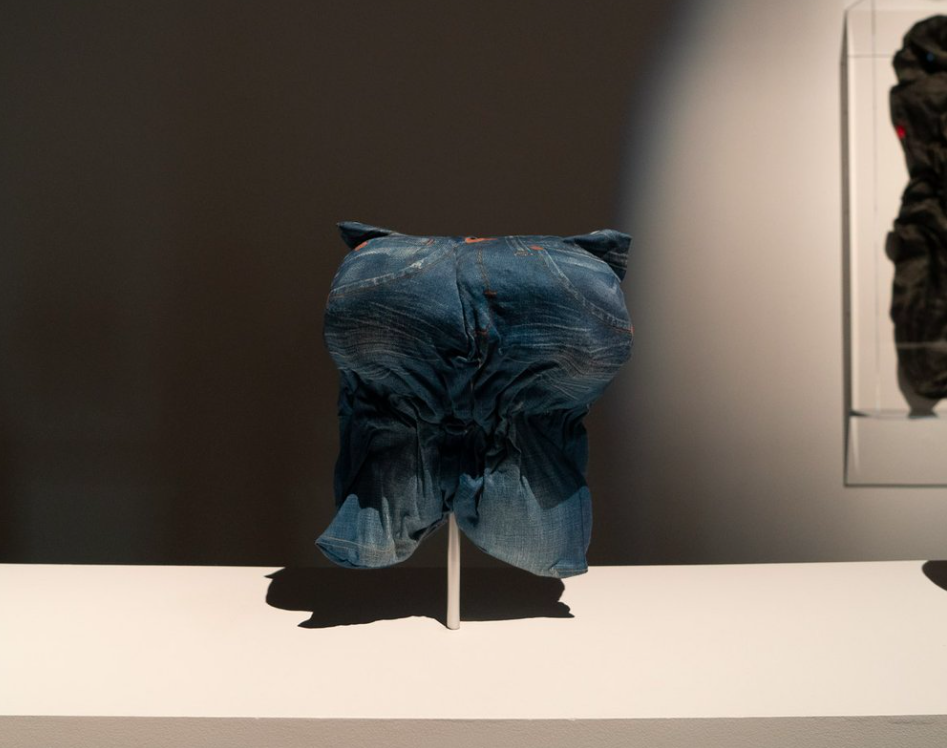Concomitant Water: Caroline Monnet’s Echoes from a Near Future | Ali Pinkney
December 13, 2022
Echoes From a Near Future, 2022, inkjet print on aluminum, 80” x 120” | image: Lesia Miga
Caroline Monnet’s solo exhibition Echoes from a Near Future runs at Arsenal Gallery in Toronto from September 16 to December 17. In works that span from 2016 to 2022, the multidisciplinary artist based in Tiohtià:ke/Montréal, with Anishinaabeg and French roots, interlaces the immaterial with the ultramodern.
Monnet’s conceptual work reveals bright entryways to temporalities of pastness and futurity that swirl beneath the surface of a poetics of identity, Indigeneity, and materiality. Characteristics of her wider oeuvre are apparent in the politically provocative thought experiments this exhibit invokes. Monnet crosses the textiles of industrial building supplies with the sensibility of atelier production of traditional garments, and, in so doing, sets hybrid correspondences into a generative poetic mode part parallelism and part juxtaposition. The artist obliquely and directly calls the relationships between the industrial complex, colonialism, Indigeneity, and humanity into the realm of interactive consideration, inviting her viewer into the fold of question with ease.
Echoes From a Near Future, Installation view at Arsenal, 2022 | image: Lesia Miga
Insulation and other manufacturing barrier materials marked with brand names familiar to hardware heads – “Airguard” and “Everbilt” – are seamlessly employed as parts of the colourful garments worn by three generations of six Indigenous women in the exhibit’s central photograph. The aesthetic of a particularly pop-cultural runway line floats over industry’s backdrop of colonial history. The idea of the origins, purposes for, and interpretative uses of these materials as perimeters, as barriers, as borders of irregular-geometry delineators ribbon through the mind. A sandbag of stitched tarp forecloses the opening of the exhibit as if to hold a floodgate – granular, weighted, unassuming in contrapposto. The use of these materials in fashion reads as subversion, where the “garments” of the industrial working man are freely accessed and consciously appropriated through a joyful employ.
Le Buste de: Maisy, 2016; Le Buste de: Shannon, 2016; Le Buste de: Sonia, 2016, cement, mini-skirt, and steel plate, 18” x 12” x 12” each | image: Lesia Miga
Piwanego / Noogom (Autrefois / Maintenant), 2021, embroidered bag, sand from Kitigan Zibi Anishinabeg, dimensions variable | image: Lesia Miga
Waterfall I, 2016, and Waterfall II, 2016, cement, denim, and wood, 96” x 24” each | image: Lesia Miga
In Waterfall I and Waterfall II, two cascades of cut strips of denim, the working man’s signature fabric, perhaps dyed with the historically contentious indigo, appear in three lengths and different shades of blue. As I gazed, I saw the strips were layered as if feathered curtains of hair down the face of the gallery wall – the wall which faces the central photograph. In the press for the exhibit, Arsenal writes that the “poetic narratives” Monnet constructs involve the projection of “new meanings onto a shared, bilateral legacy” – such a bilateral legacy can be seen shooting through these works in the centre of the exhibition space. The sculptures cast shadows on and over themselves. The shadows are slanted like poised wings on the concrete floor of the warehouse space that supports their wooden, cemented standing. Or perhaps these shadows are the impressions of fish fins beneath the surface of still water? Are they past? future? humanity to industry, industry to humanity? The concepts do-si-do, and I leave considering how social and literal structures, which divide to use or honour land, are told by the languages of water, how water seeks ground, how light both shows and burns fluid stories away.
Caroline Monnet (Anishinaabe/French) is a multidisciplinary artist from Outaouais, Québec. She studied Sociology and Communication at the University of Ottawa and the University of Granada before pursuing a career in visual arts and film. Her work has been programmed internationally at the Palais de Tokyo, Haus der Kulturen der Welt, Whitney Biennial, Toronto Biennale of Art, Museum of Contemporary Art, Arsenal Contemporary, Walter Phillips Gallery, and the National Art Gallery. Monnet is recipient of the 2021 Hopper Prize, 2020 Pierre-Ayot award, the 2020 Sobey Art Award, the REVEAL Indigenous Art Awards, as well as grants from the Canada Council for the Arts, Conseil des arts et des lettres du Québec, and from Conseil des arts de Montréal. She is based in Tiohtià:ke/Montréal and is represented by Blouin Division Gallery.
Ali Pinkney is a literary writer who attends the University of Toronto in Tkaron:to/Toronto where she is composing a research novel in poetics graciously supported by a SSHRC Canada Graduate Scholarship and an Avie Bennett Award. Ali holds a BA in English and Creative Writing and an MA in English Literature from Concordia University in Tiohtià:ke/Montréal where she held her year’s Steinberg Scholarship, David McKeen award, and a fellowship with the Faculty of Arts and Science which culminated in her research on the figuration of "wingèd thought" in the works of Percy Shelley.
Images courtesy of Arsenal Contemporary Art Toronto.







